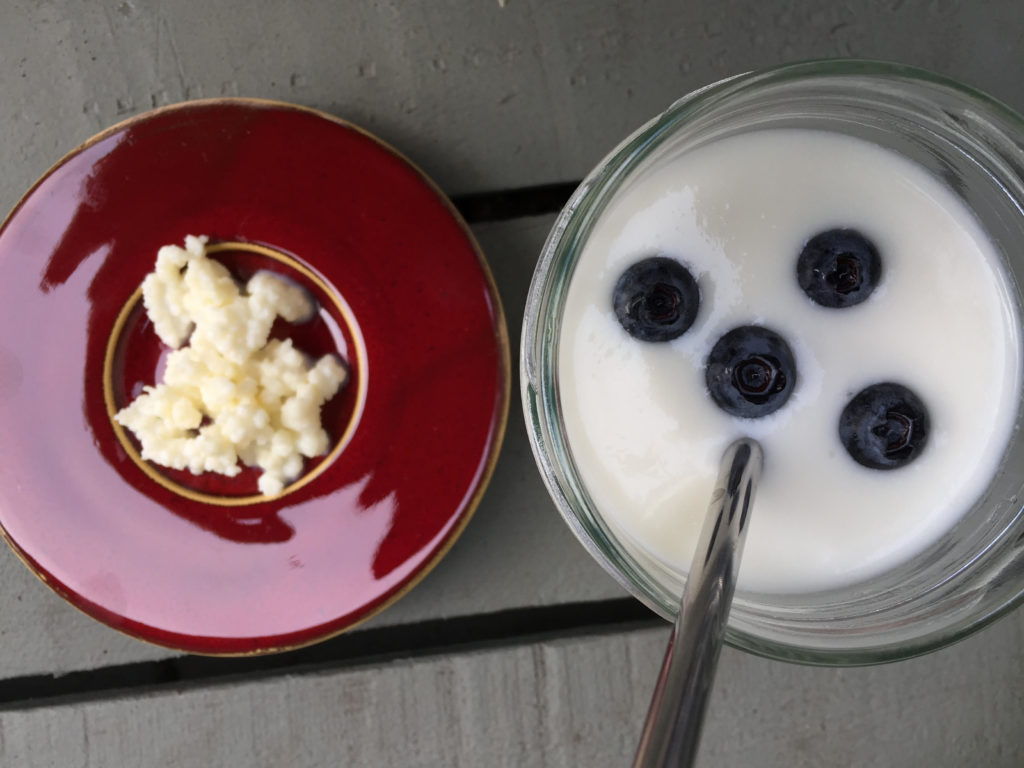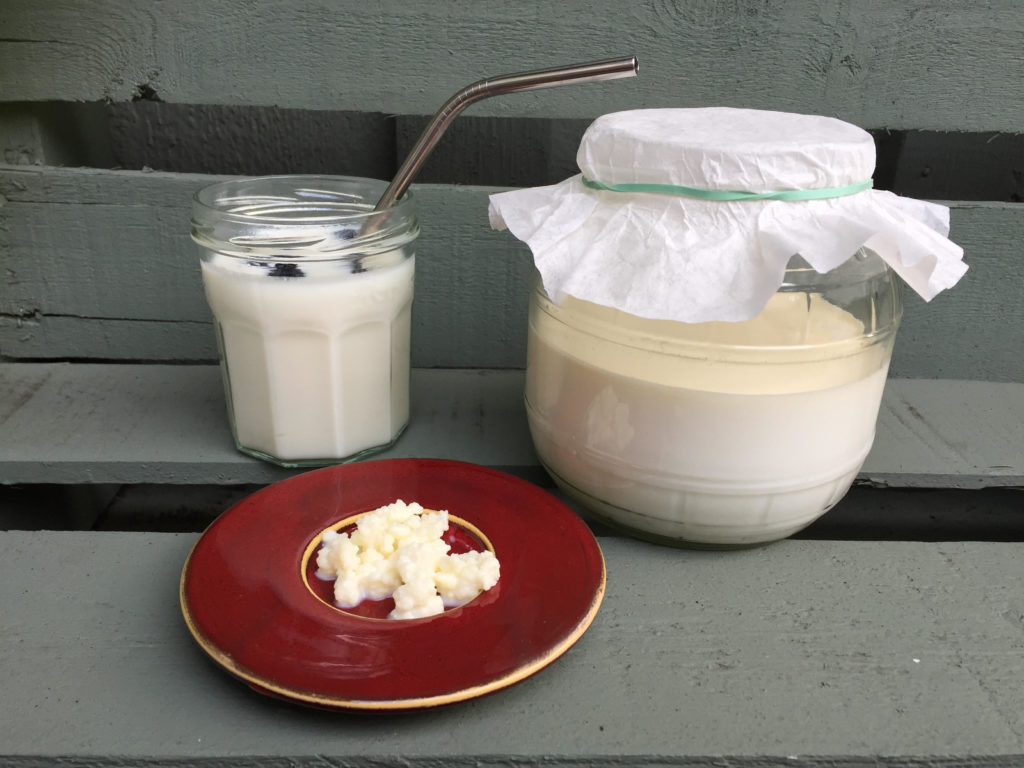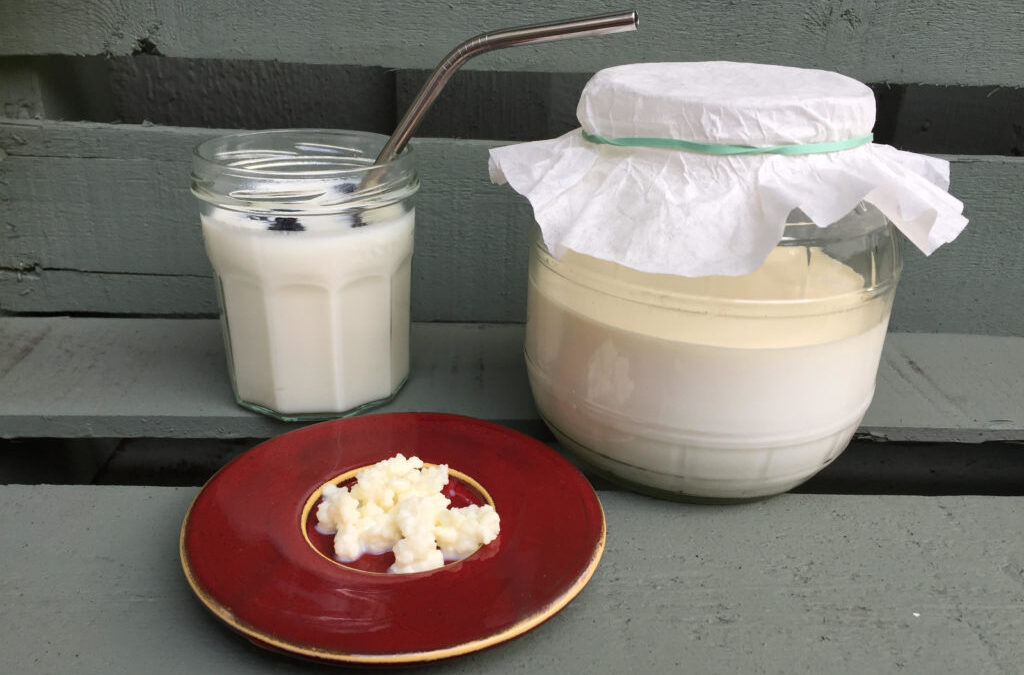Milk Kefir – is a fermented dairy drink filled with loads of good bacteria and their products, that were created during fermentation. It originated roughly 2,000 years ago in the Caucasian Mountains between Europe and Russia, which makes kefir one of the oldest milk ferments in existence. Kefir is a wonderfully delicious slightly carbonated fermented milk beverage similar to yogurt (or buttermilk).
Due to numerous probiotic bacteria this fermented dairy drink has many wonderful health benefits, a great flavor and is also usually tolerated well by the lactose intolerant. It’s much easier to make than yogurt, and kefir has a much larger spectrum of probiotics than yogurt. The reusable, sustainable grains also make it more economical. The popularity of this trendy drink is growing rapidly but it’s quite pricy like kombucha.
Here are some of the health benefits of milk kefir:
- It can improve lipid profile in serum as per recent randomised clinical trial. Specific strain of Lactobacillus fermented ME-3 isolated from kefir was also shown to improve blood lipoprotein profile which means it can regulate a healthy cholesterol levels in you body.
- Kefir has been shown to contribute to weight loss in high-fat-diet-fed mice by changing microbiota and mycobiota (composition of fungi in the gut).
- Kefir showed anti-tumor effects in a breast cancer model in mice.
- Anti-allergic and anti-inflammatory properties.
- Shows antimicrobial and protective properties by inhibiting the growth of such pathogenic bacteria and Streptococcus sp.
- Helps with lactose intolerance and lactose digestion in adults when consumed together.
- According to the recent study from researchers in Ireland regular consumption of kefir improved stress parameters and increased GABA production by gut microbes in mice.
- Another recent study on fly model for Alzheimer’s Disease (AD) showed that kefir consumption in its natural form improved neurodegeneration index and overall neurological status of flies. Similar results were obtained with the mouse AD model.
- AD patients from a clinical trial in Brasil also benefited from using kefir on a daily basis for 3 months. 2 ml per kg of weight of kefir was used daily. Number of factors improved such as memory; oxidative stress and blood cell damage were reduced. If you weigh 50 kg then you should drink 100 ml of kefir a day according to this study to get the same benefit.

Here is what you need and how to make it.
Equipment:
- Wide Mount Quart-Size (1L) Glass Jar or Mason Jar Drinking Glass (0.5 l) which is convenient as you can drink right from it. You can also get plastic lids that you can use for storing kefir in mason jar drinking glass in the refrigerator.
- Stirring Utensil (Plastic or Wooden [I prefer a good quality plastic to avoid cross contamination])
- Fine Nylon Mesh Strainer Cheese Cloth or Paper Coffee Filter (I am personally using coffee filters)
- Rubber Band (to secure the cheese cloth or coffee filter to the jar)
- Quart Measuring cup or Measuring Scales. I actually prefer to use scales when I measure milk.
- Glass bottle for bottling (I am recycling 16-18 oz kombucha bottles with plastic cap purchased at the grocery stores). If you chose to use Mason Jar Drinking Glass then you use it for storage too!
- Norwex Envirocloth for cleaning all the surfaces and making sure you don’t get contamination.
- Stainless Steel Straws if you decide to add some berries and enjoy it as a smoothie.
Ingredients:
- 0.5 L Organic Whole Milk
- 1 Tbsp Milk Kefir Grains
Milk Kefir Preparation Method
- Clean the surface first to make sure kefir grains don’t get contaminated by the bacteria from the environment. Advice from a microbiologist 🙂 I don’t like using toxic chemicals therefore I clean my surfaces with cloth and water.
- Pore milk in a glass jar.
- Add the grains into the milk using clean spoon. You can use as little as 1 tsp and as much as 1 tbsp. The more grains you will use the more sour it will turn out. So you can experiment with the amount of grains you prefer. They will be multiplying pretty quickly, therefore you can store the extra in refrigerator covered with milk or share with a friend.
- Cover the jar with a cheese cloth, coffee filter or any other tight-woven but breathable towel or and secure with a rubber band.
- Leave the milk with grains to ferment at room temperature for 24 hours. This stage is also called – feeding the grains. The grains are feeding on the lactose present in the milk
- Mix the mixture of fresh kefir and the grains. The mixture can be as thick as the sour cream. Be gentle to not smash the grains.
- Strain the grains using the fine mesh strainer. You may need to mix the mixture gently with the plastic spoon while straining because the mixture is pretty thick.
- Cover the jar with a cheese cloth, coffee filter or any other tight-woven but breathable towel or and secure with a rubber band.
- Repeat from step 1. Place the strained grains into fresh cold 0.5 milk jar.
- The strained kefir drink is ready to drink or place it to the refrigerator.
- Enjoy

Recipes
Recipes about how to make smoothies with kefir, home made cottage cheese and “syrniki” (cottage cheese fritters) are coming soon on my blog.


Dear Karina, hello!
I want to try to make kefir. What culture/bacteria brand you’d recommend to use? does it taste anything like the kefir sold in the Russian shops?
Thanks sincerely. Your devoted reader.
Natasha
Hello Natasha! Thank you so much for your comment. I would definitely recommend a homemade kefir to the one you can purchase at the store. The ones that are sold at the stores usually are made with a starter culture using only few bacteria while the milk kefir grains contain between 20-30 different strains. And the more strains the better. Here is the link where you can purchase the cultures http://mygutmatters.com/live_cultures/ you can also email me @ mygutmatters@gmail.com
Hope that helps.
Thank you.
Karina
BABLOFIL, Thank you so much for your feedback!
Karina, thank you for the article. Quick question, advising two. 1) I consumed a glass of homemade kefir every morning during my second pregnancy, now my baby is allergic to milk protein, any possible correlation you could make? The doctor told me to stay away from dairy, eggs, soy, oats, nuts while I breastfeed. 2) do bacteria consume protein during fermentation? Can I drink kefir and not cause allergic reaction in my son’s body? Thanks.
Hello Natalia, thank you for your questions. I need a little bit more information. Like is the baby allergic or sensitive to the dairy products? Are you sure its dairy or/and maybe other products? Consumption of milk kefir during pregnancy should have served you and your baby well because it have a lot of probiotic bacteria in it. Bacteria are not consuming the protein. They feed on carbohydrates. If the baby is allergic to dairy they you should not consume any dairy at all. But remember that allergy is a severe and sometimes life threatening reaction. Feel free to contact me if you want to schedule free 15 min consultation here http://mygutmatters.com/work-with-karina/
Thank you, Karina!!! Today I had a first glass of my own milk kefir from the gains I ordered from you! It is delicious! Thank you very much!!! You are doing a great thing informing people about their health and helping become healthier and happier! We love you!
Hi Karina, thanks a lot for your blog. I want to order Kefir or Kombucha but I am not sure which one is better for me. I suffer from bloating and gaz, also fighting with Candida.
Thank you , Natalia.
Hello Natalia, I would recommend to start with kombucha although both could be beneficial to you.
Hi,
I got my grains! Just wondering if the grains can ever go bad and how you would tell? Also, a bit confused with your recipe, Do i strain the grains after 24 hours and then let it sit for another 24 hours? It says to repeat from step one after the grains are strained out. Thanks
Dear Lisa! Thank you for purchasing my grains! Potentially they can starve to death if they are not taken care of. Then the fermentation is not going to take place.
Apologies for the confusion. You strain the grains and then place them to fresh milk for a new 24 hour cycle. So potentially you will have a new batch of milk kefir everyday.
It may take a bit for the grains to adjust after the trip to a different state. So don’t panic if you don’t have a perfect kefir in 24 hours. You may need to incubate it longer and then strain to a fresh milk. It can take up to a week before the grains become 100% viable. Please let me know if you have any troubles.
Best wishes,
Karina
Thanks! thats good to know. I think they were a little sad when I got them after being in the mail for a week, but I will nurse them back to full health!
I am sorry , in the step 7 we separate kefir and grains , correct ? And step 8 is a new batch ?
Thank you
Sorry for the delay in my response. Yes, you were totally right. After you separate the grains from the kefir you can transfer them into a fresh milk for the next batch of kefir to be made.
Hi, my grains are doing well and I’m enjoying kefir daily. Another question about the grains, is it possible for them to become un-balanced, to yeasty or one microflora proliferating over the others?
Hi Lisa! Great to hear that you are enjoying your milk kefir! If you take good care of your grains you should not worry about the composition of the grains an kefir. The culture is pretty stable. As long as you “feed” them with the fresh milk every 24 hours they should be good. If you leave them for days on the countertop then there is a change of disbalance and your kefir will be more “yeasty” and not as yummy.
Just received my grains , not sure how long it was on the way. I put them into milk, and 24 hours later there is thick layer on top and clear liquid at the bottom. Am I doing something wrong ? Thank you
Hello Kate, sometimes it may take some time for the grains to adopt to the new conditions. They are deftly alive and working but you may need to transfer them into a fresh milk a few times before it generates a real kefir. Let me know please if you were able to figure it out. I hope it is working by now.
I’d like to make a kefir to increase the probiotic ME-3 RegActiv. clinical trials were done using a kefir with ME-3. how would I do that? Thanks.
We have connected via email but I will duplicate here. Yes, you are right Lactobacillus fermentum ME-3 was isolated from kefir. That’s why I suggest to use kefir on a regular basis. Different kefir culture however may have slightly different strains of the same species therefore unless we test particular kefir culture we cant’s say for sure that it will have exactly the same strain with the same properties.
You can potentially add this bacterium from the capsule and use it with your kefir, however there is no guarantee it will establish and become part of the community. It is worth trying but there is no guarantee. And you have to test the cultures to know for sure what’s going on with them.
I hope this helps.
Just received my grains. I put them into milk, and after 24 hours there is thick layer on top and clear liquid, like whey at the bottom. The taste is a little bitter. Is that right?
Hello Petru, what kind of milk are you using? I recommend to start with pasteurized and homogenized organic or pasture-raised milk first. They you should not have a top cream part. If you see your milk separating (clear fraction and curd), it often mean that over fermented. It happens when temperature in the room is too high and microorganisms multiply too quickly. You can reduce the amount of grains and shorten the fermentation time. I hope that helps.